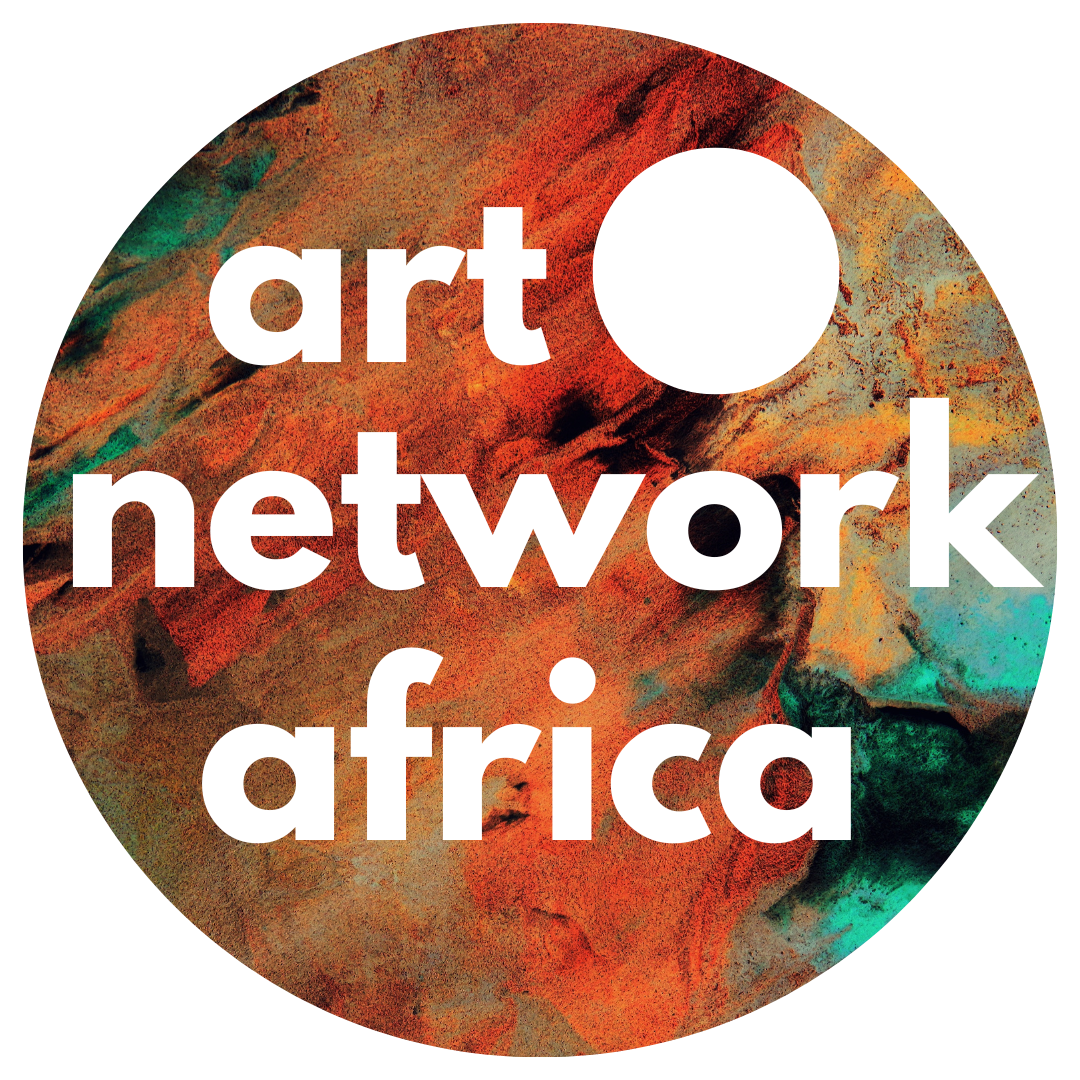A number of African artists under 35 are steadily building momentum. Their work is showing up in major exhibitions, featuring in notable collections, and sparking conversation across disciplines. Some approach their practice through bold material experimentation, while others draw deeply from history and lived experience. What unites them is a deliberate, thoughtful engagement with the world around them.
This list doesn’t aim to predict the future, it reflects a present already in motion. Here are 10 African artists under 35 that are making work that demands attention.
1. Deborah Segun (b. 1994, Nigeria)
Working from Lagos, Deborah Segun’s paintings navigate the complexities of self-perception through a distinct lens. Her deconstructed, often Cubist-inspired compositions exaggerate the female form with fragmented silhouettes, contemplative poses, and bold shapes, recalling both art historical references like The Venus of Willendorf and Picasso, while firmly asserting her own visual language.
Deborah’s work leans inward. Drawing from personal experience, she treats the canvas as a space for psychological excavation, mapping transitions between self-doubt and self-acceptance, and reflecting broader conversations around womanhood, identity, and balance. Her paintings resist easy interpretation: they are vibrant yet veiled, protective yet revealing: serving as a visual diary of a young artist shaping her interior world in real time.

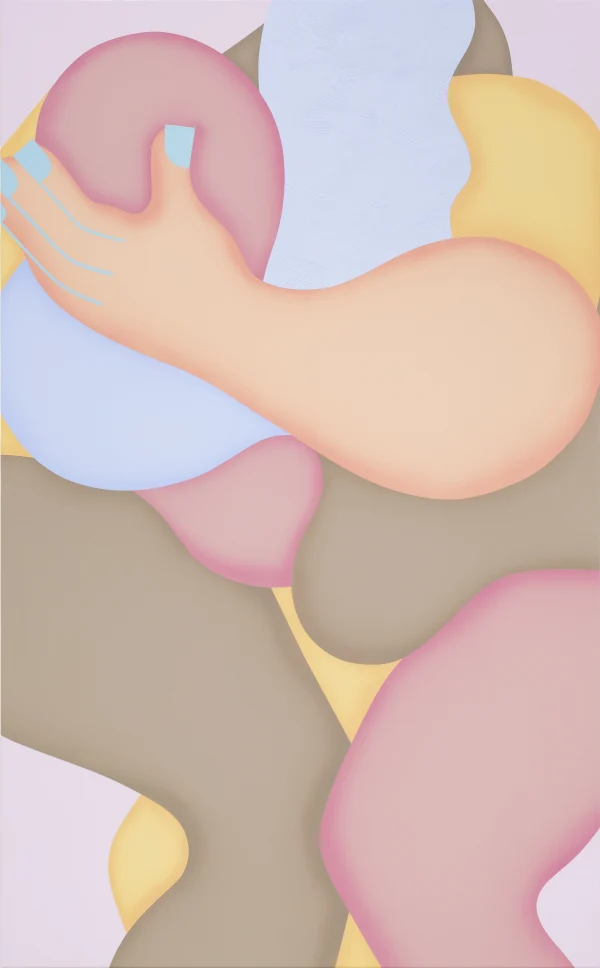
Trained in fashion design at Polimoda in Florence, Deborah has held solo exhibitions across London, Athens, Accra, and Lagos, with recent shows at Saatchi Gallery (2024) and The Breeder Gallery (2024). Her work has also been featured at major fairs including Frieze (London, New York, Los Angeles), 1-54 Contemporary African Art Fair, FIAC, and Art Cologne.
Recently, Deborah collaborated with Infiniment Coty Paris, painting limited-edition perfume bottles, and launched a virtual exhibition titled A Love Letter to My Soul on Vortic Art, presented by Galerie L’Appartement (15 May – 24 July 2025).
Her work can be found on Artsy.
2. Chigozie Obi (b. 1997, Nigeria)
Chigozie Obi’s multidisciplinary practice centers on storytelling; it is layered, personal, and deeply resonant. Working across painting, digital media, photography, and installation, she explores themes ranging from mental health and self-acceptance to cultural narratives around womanhood, activism, and healing. Her work is rooted in lived experience but opens itself up as a mirror to wider social realities, creating space for both individual reflection and collective connection.
A graduate of the University of Lagos’ Visual Arts program, Chigozie has exhibited in Lagos, Vienna, Milan, and Los Angeles, and recently participated in In Stillness of Being at Yenwa Gallery (2024) and Celebrating Identities at AG18 Gallery in Vienna (2024). Her growing international profile includes a residency at Gasworks, London (2022) and appearances at 1-54 Contemporary African Art Fair in Marrakech (2025). In 2021, she won both the Access Bank Art X Prize and The Future Awards Africa Prize for Art.
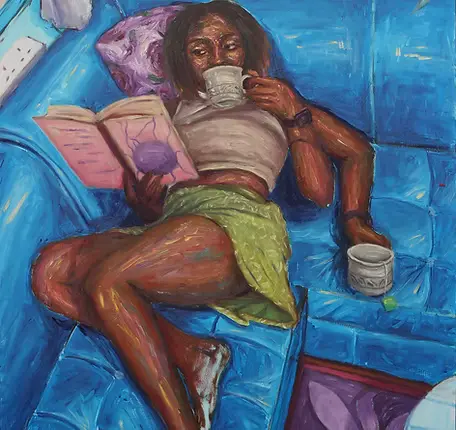
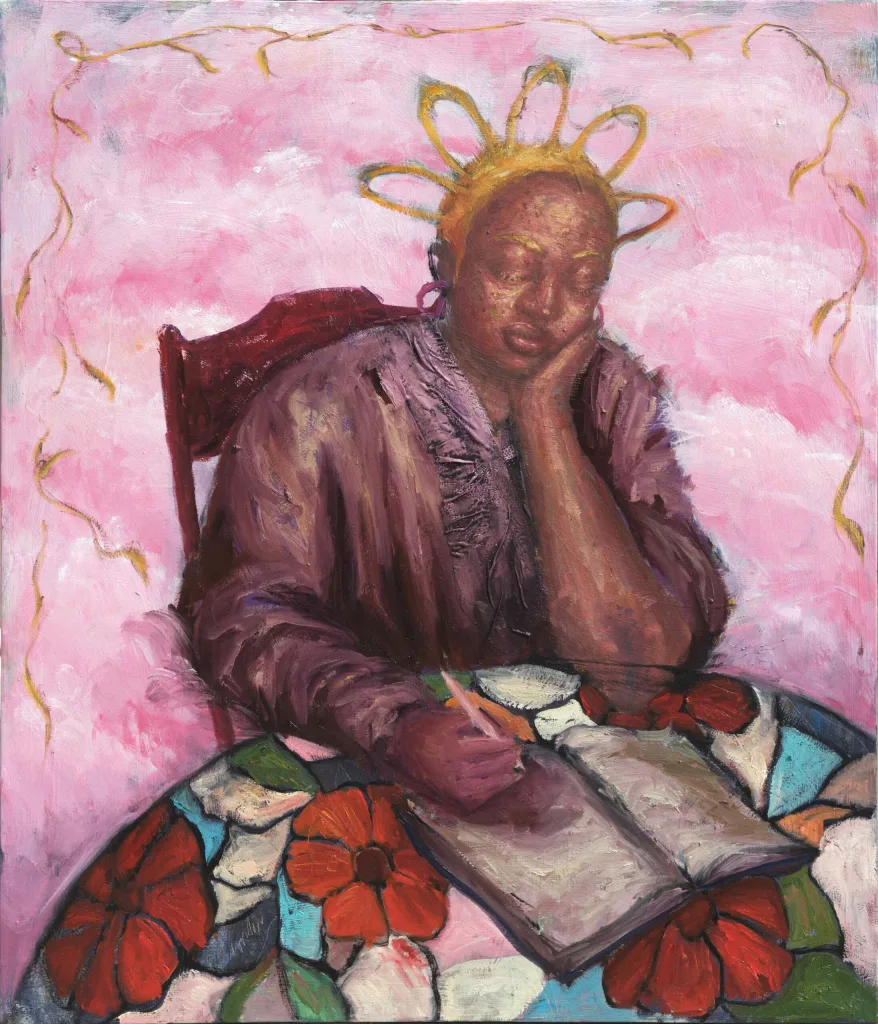
Beyond her studio practice, Chigozie also builds platforms for others. She is building the Art Resource Collective, a support network for creatives, and maintains Gozie.jpg, a digital art archive, where she contributed a commission for Fifteen Colonial Thefts, published by Pluto Books (UK). Her photo journal, Le Journal De Gozie, captures the quieter, everyday dimensions of her creative life.
Her work can be found on Artsy, she also sells art prints and can be contacted through her email.
3. Kwesi Botchway (b. 1994, Ghana)
Working from Accra, Kwesi Botchway paints striking portraits that center Black beauty, emotion, and futurity. Known for his signature use of purple skin tones and orange-hued eyes, Kwesi creates figures that resist the white gaze, embodying both the power of presence and the richness of inner life. His brushwork, influenced by French Impressionism and African realism, layers texture and meaning to reframe how Blackness is seen, felt, and remembered.
Rooted in both classical technique and street art beginnings, Kwesi studied at Ghanatta College of Art and Design and the Academy of Visual Arts in Frankfurt. He later founded WorldFaze Art Studio in Accra, a residency and mentorship space supporting young artists.
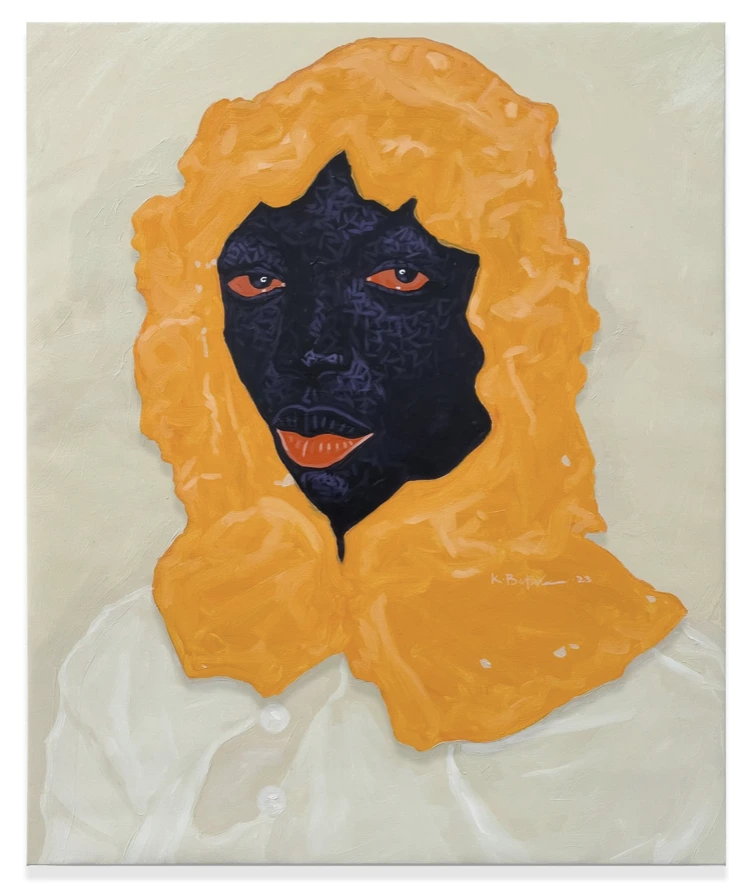

His work has been exhibited internationally, with solo and group shows across Ghana, Germany, Belgium, the UK, and Denmark. Highlights include Art Brussels Week, 1-54 Contemporary African Art Fair, and recent solo exhibitions with Gallery 1957 and Maruani Mercier. His paintings are held in major collections including the Brooklyn Museum (New York), ICA Miami, and the National Gallery of Victoria (Melbourne).
Kwesi’s portraits don’t just depict Black subjects, they create a visual language of reverence, resistance, and reimagination.
His work can be found on Artsy, and he can be contacted through his email.
4. Rahma Lhoussig (b. 1996, Morocco)
Rahma Lhoussig’s work draws from the porous space between dream and memory. A graduate of the National Institute of Fine Arts in Tétouan, she channels her unconscious visions into paintings and drawings that blur the line between allegory and narrative. Her compositions often feature fragmented bodies, sometimes hybrid, sometimes dissolving, and entangled with zoomorphic or everyday forms, evoking unresolved inner conflict and the surreal logic of dreams.
Positioned within a visual language of the unfinished, her works resist closure: lines unravel, forms evaporate, and meaning hovers just out of reach. Through this, Rahma constructs a world where internal states take shape in a delicate, ambiguous, and emotionally resonant way.

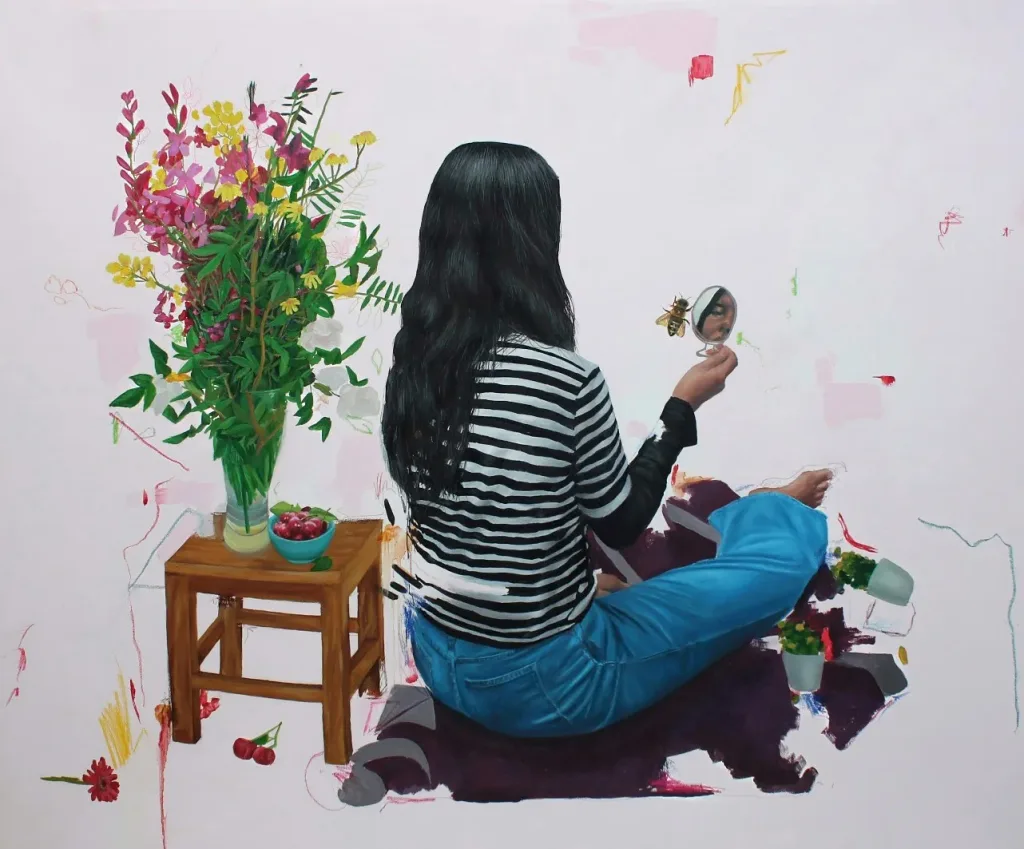
Her recent exhibitions include Les Saisons at La Galerie 38 (2025) and Un-Buried Memories at the African Arty Gallery, Casablanca for the 1-54 Contemporary African Art Fair, Marrakech (2023). She also participated in the Investec Cape Town Art Fair (2022) and the group exhibition Art is Child’s Play at the African Arty Gallery, Casablanca.
Rahma’s practice is as much introspective as it is expansive which mapped the psychic terrain where the symbolic and the subconscious intertwine.
Her work can be found on Artsy.
5. Samy Snoussi (b. 1993, France)
Based in Casablanca, Samy Snoussi is a French-Moroccan multidisciplinary artist whose work spans photography, sculpture, murals, installation, and performance. With a background in urban design and art history, Samy transforms public and private spaces alike by crafting visual languages that blend contemporary aesthetics with ancestral craft techniques. At the heart of his practice is the body: not only as a material but as a metaphor for individuality, resistance, and social belonging.
A dyslexic and dysorthographic artist, Samy draws on personal and global experience to forge a symbolic, line-based visual vocabulary. His works often blur the boundaries between the textual and the gestural, prompting viewers to question systems of communication, the politics of legibility, and the individual’s role within the collective. Whether through mural or sculpture, canvas or skin, each piece is an open invitation to unity, introspection, and transformation.
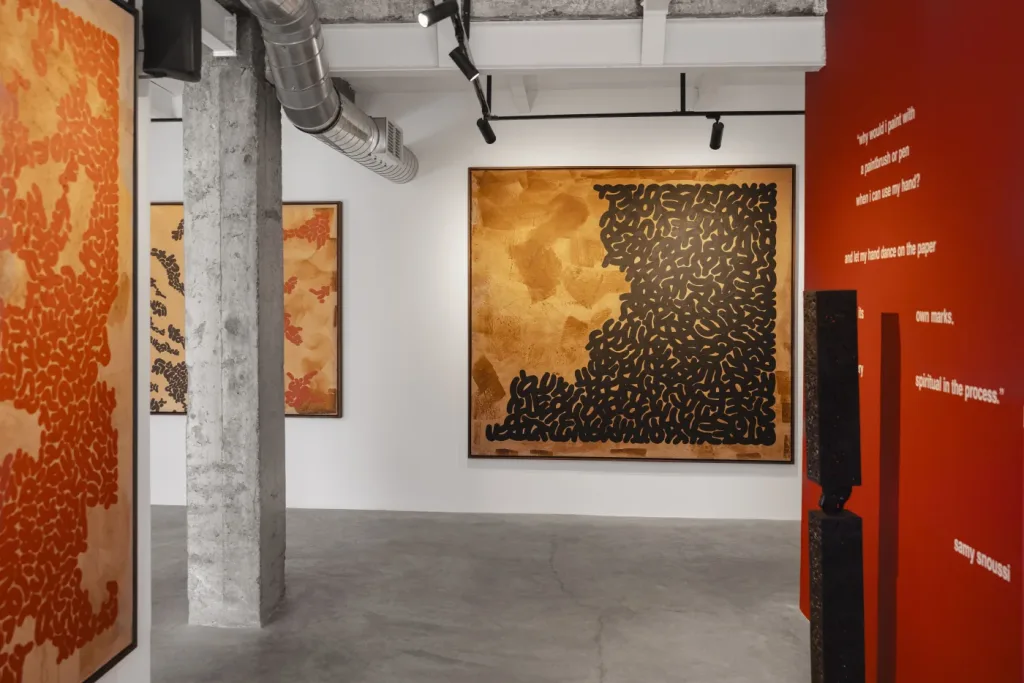

After years in Montreal where he worked as an urban consultant while developing his art, Samy returned to Morocco, where his work now extends into collaborations with local artisans and communities. Recent exhibitions include My Hand, Your Eyes, The Third Space (solo, Loft Art Gallery, Casablanca, 2025), XYZt (group, Loft Art Gallery, Casablanca, 2024), and Amur Yakus (group, Loft Art Gallery, Marrakech, 2024). Previous solo and group presentations span the MENART Fair (Paris), Côte d’Ivoire, the UK, Italy, Dubai, and the University of New Orleans.
Samy’s practice is a continuous search for form, meaning, and a more embodied way of being in the world.
His work can be found on Artsy.
6. Boemo Diale (b. 2000, South Africa)
Boemo Diale is a multidisciplinary artist whose work navigates the terrain of identity, generational trauma, spirituality, and self-fashioning. Raised between Rustenburg and suburban Johannesburg, her practice reflects the complexity of growing up as a mixed-race woman within layered racial and socio-political structures. Her work explores what it means to carry inherited memory (maternal, cultural, and spiritual) while also imagining new forms of becoming. Across her work, Boemo merges personal storytelling with cultural motifs, drawing from San rock art and spiritual iconography. She frequently returns to the image of the pot, both as a visual anchor and symbolic container for dreams, grief, and ancestral knowledge.
Working across painting, printmaking, and sculptures, Boemo often builds immersive environments that extend her visual language beyond the surface. Her collaboration with Rabson Bwalya on carved ‘Zambia’ frames, her sculptural ceramics, and her early training in film all point to a layered, narrative-driven approach. Her work invites viewers into an emotional and historical excavation.

In 2022, she interned at David Krut Workshop, where she began exploring how printmaking could expand her vocabulary. This culminated in her 2023 debut print-focused exhibition Can I Play?, and she continues to develop etchings and monotypes with David Kurt Workshop’s Kim-Lee Loggenberg-Tim.
Her recent solo exhibitions include Tswala Gate at Kalashnikovv Gallery (2025); The Orange Tree of Lemenong at Everard Read, Cape Town (2024); and No Matter How Far I Run at Kalashnikovv Gallery, Johannesburg (2023). She has exhibited internationally at 1-54 Contemporary African Art Fairs, Untitled Art (Miami Beach), and the Brooklyn Art Fair through David Krut Projects. In 2024, she was awarded the Tomorrows/Today Artist Prize at the Investec Cape Town Art Fair. She has been featured in Wanted Online, Nataal, and Glamour Magazine’s 2025 Trailblazing Women in Art.
Through her multidimensional forms, Boemo Diale offers a space for an evolving visual language of reclamation, tenderness, and resistance.
Her work can be found on Artsy.
7. Athenkosi Kwinana (b. 1995, South Africa)
Athenkosi Kwinana is a Johannesburg-based visual art activist whose practice confronts the social and structural discrimination faced by Persons with Albinism (PWA) in South Africa. Working primarily in drawing and printmaking, Kwinana challenges deeply ingrained stigmas through visuals that advocate for visibility, empathy, and change. Her work is both personal and political; it is anchored in lived experience and sustained by a commitment to social justice.
In 2022, she was awarded the Cultures Resistance Award and selected for the Tilga Art Fund, and in 2023, she received a grant from the Elizabeth Greenshields Foundation, recognizing her strength in traditional draftsmanship. She has completed artist residencies in Havana, Cuba, and Brazil, expanding her praxis across borders.
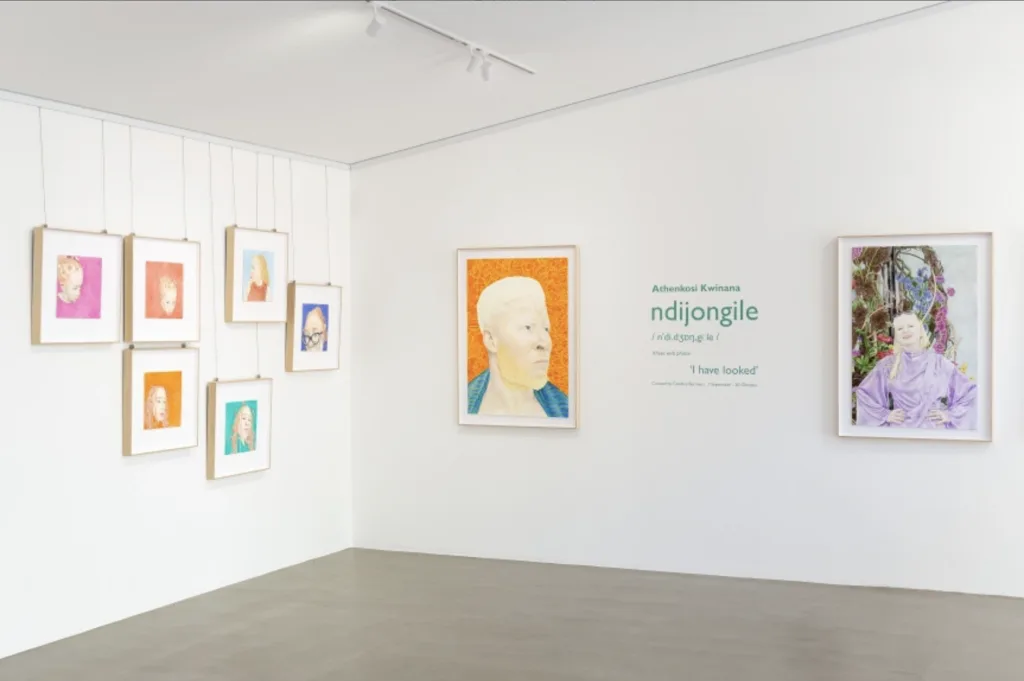
Athenkosi’s work has been exhibited at 1-54 Contemporary African Art Fair in London and New York, as well as at the Investec Cape Town Art Fair, where she presented a solo booth in 2023. In 2024, she debuted her first solo exhibition with Berman Contemporary (which she is represented by), Ndijongile, and this was part of a broader Albinism Awareness Month initiative incorporating a timeline, panel discussion, and group show. She has been a regular contributor to Berman Contemporary’s programming since 2022.
Athenkosi’s visual language is quiet but urgent; her practice can be described as an act of resistance and rehumanization. Through it, she not only affirms the presence of those historically misrepresented, but also reframes how difference is seen, honored, and protected.
Her work can be found on Artsy.
8. Amina Yahia (b. 2000, Egypt)
Cairo-born artist Amina Yahia explores the intersections of belief, control, and ritual through a distinctly satirical lens. Her large-scale figurative paintings examine socially conditioned behaviors and the near-spiritual repetition embedded in daily routines. Rooted in post- and neocolonial Egyptian society, Amina’s practice probes how familial, political and religious systems manifest in bodily movement and identity, especially as they relate to women.
Female subjectivity is central to her work. Through distorted, often life-sized figures, she critiques the subtle violence and sensuality embedded in cultural norms. Her painted bodies evoke the uncanny and intimate, tracing the friction between autonomy and tradition. There is a ritual logic in her compositions, where the banal becomes sacred and control is both literal and psychological.
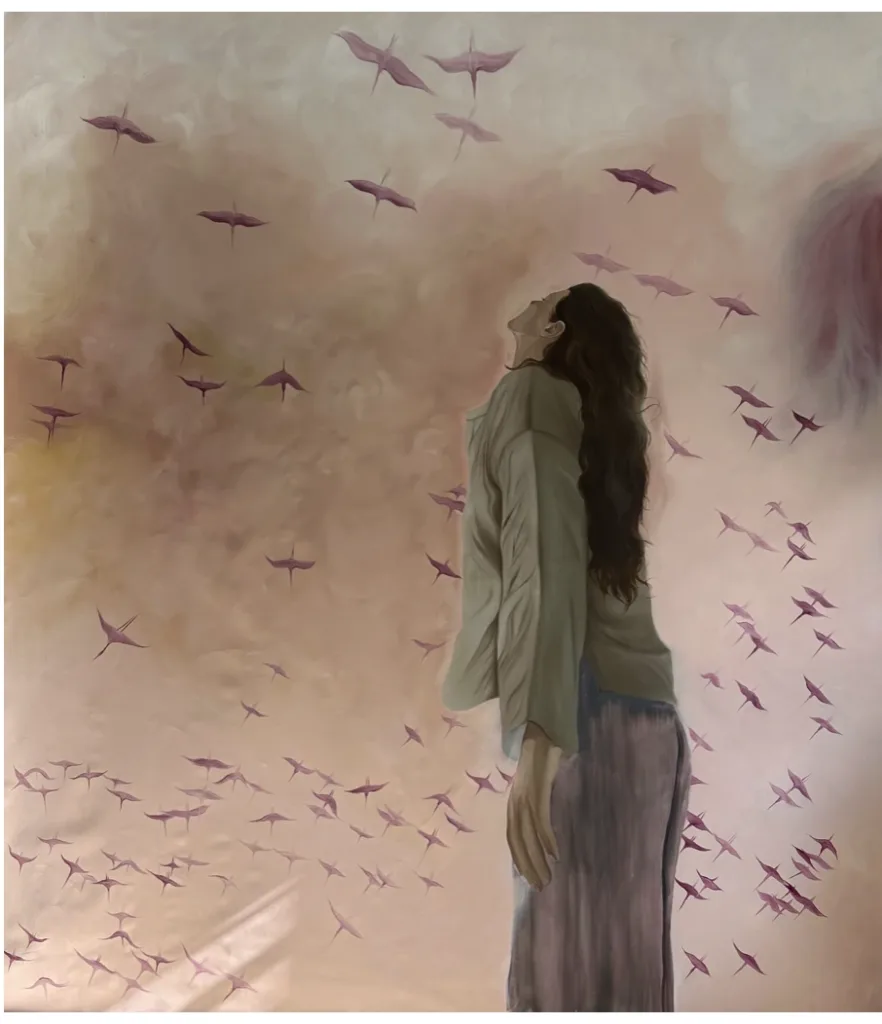

Amina holds a BA from New York University and has exhibited at venues including Shelter Art Space (Alexandria), Medrar (Cairo), 421 (Abu Dhabi), Tahrir Cultural Center at AUC (Cairo), and Firetti Contemporary (Dubai). She has also participated in the Menart Fair (Paris).
Amina is represented by the Hunna Art Gallery and featured in its debut presentation at 1-54 Contemporary African Art Fair, Marrakech 2025. Through her visual language, she rewires folklore and surveillance into forms of resistance, laying bare the choreography of belief inscribed onto the body.
Her work can be found on Artsy, and she can be contacted through her email.
9. Abongile Sidzumo (b. 1996, South Africa)
Abongile Sidzumo is a visual artist whose work explores the fragility and resilience of memory, material, and community. A graduate of the Michaelis School of Fine Art (2019), Abongile constructs his practice around leather offcuts and repurposed materials, resources he stitches, weaves, and layers to form contemplative pieces that reckon with the everyday textures of Black life in South Africa. Rooted in both personal history and cultural inheritance, his work reflects on the spaces he has lived in and the experiences of marginalised communities that shape his worldview.
Leather, a material derived from cattle and deeply embedded in rural South African life, becomes a metaphorical and material anchor in Abongile’s work. While often associated with wealth, status, and luxury, leather in his hands becomes something else entirely: fragmented and reassembled to speak of sacrifice, repair, and the slow, ongoing processes of healing. In repurposing what has been discarded, Abongile invites a reconsideration of how value is assigned, and what it means to extend the life of something deemed expendable.
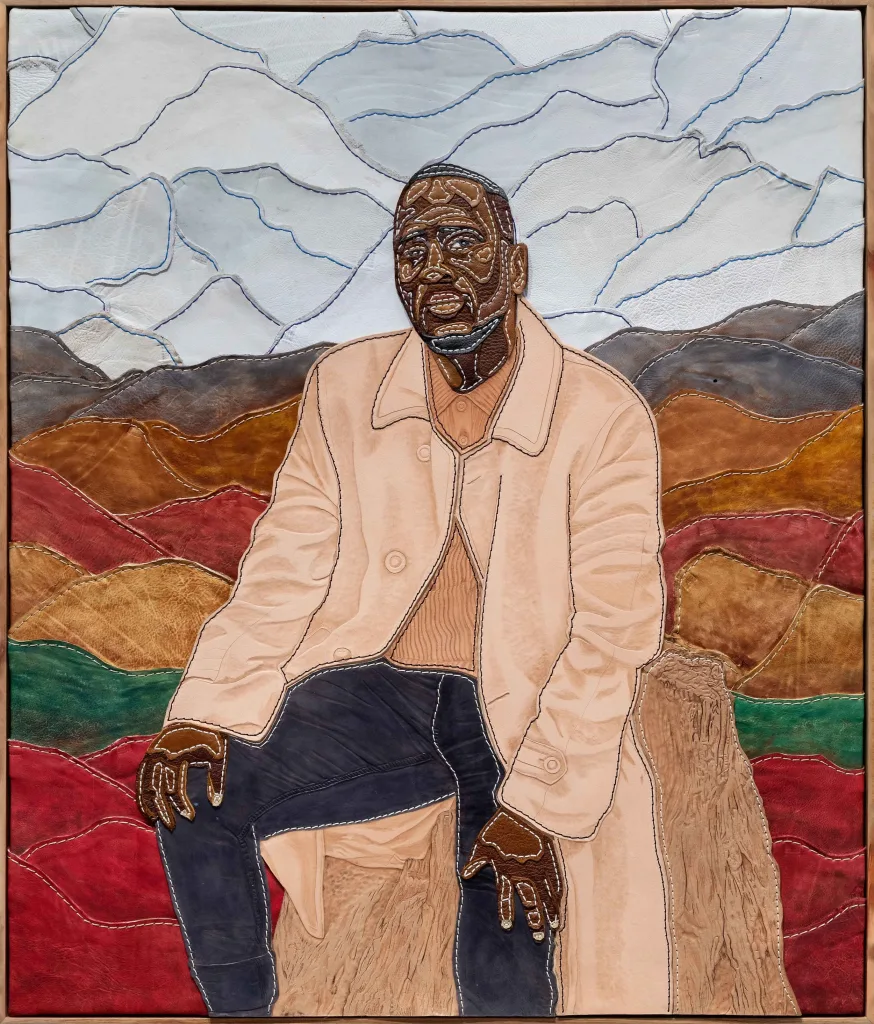
His visual language is as tactile as it is conceptual, each composition becomes a site for investigating the spiritual, emotional, and social scars inherited from apartheid, and how those marks continue to shape post-apartheid Black South African identity. In this way, Abongile’s practice operates as both archive and intervention, a means of remembering and reimagining.
Since receiving the Blessing Ngobeni Art Prize in 2020, Abongile has continued to gain momentum, with solo exhibitions including Dancing in the Dust at Everard Read Gallery (2020) and Amagoduka at Absa Gallery (2021). In 2021, he was also awarded the Gerard Sekoto Prize from Absa L’Atelier, and in 2025, named a semifinalist for the Tilga Art Prize. He has participated in major art fairs such as 1-54 New York (2025), Investec Cape Town Art Fair (2024–2025), RMB Latitudes (2025), and FNB Art Joburg (2024), among others.
Across his work is a consistent invitation: to look closer at the histories embedded within the materials. Abongile’s pieces do not demand resolution; rather, they ask us to dwell in the in-between: between the rupture and the repair, the trauma and the transformation.
His work can be found on Artsy.
10. Emmanuel Kwaku Yaro (b. 1995, Ghana)
Based in Labadi, Accra, Emmanuel Kwaku Yaro is a mixed-media artist whose work transforms everyday materials into meditations on social, religious, and economic life. Working primarily with polypropylene, a synthetic polymer commonly found in mats and shopping bags, Kwaku uses this material to explore notions of resourcefulness, ritual, and community.
Born and raised in Labadi, Kwaku’s practice is shaped by his environment and a belief in art’s ability to elevate the ordinary. Inspired by artists like Georges Seurat and Sami Bentil, he fuses European pointillism with African storytelling traditions, creating layered works that speak to the resilience and ingenuity of the African experience. His pointillist technique, which is reminiscent of Labadi, becomes both a formal device and a gesture of collective acknowledgment. Kwaku’s approach also challenges sensory limitation; he describes his process as one that exceeds the five senses, relying on intuition and a spiritual attentiveness to detail.
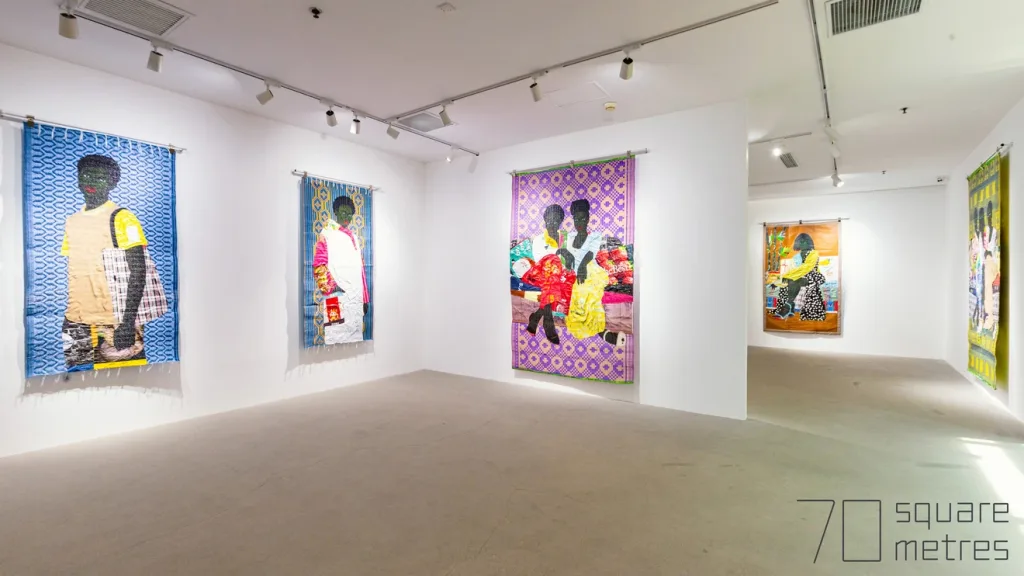
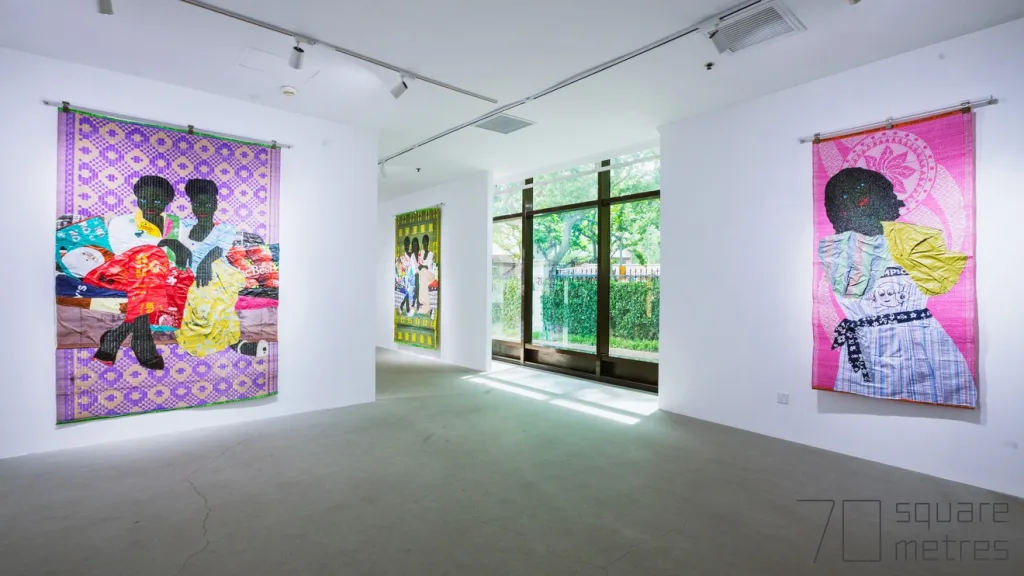
He is a member of the Artemartis collective in Accra and has exhibited widely, including solo exhibitions such as A Night Out with Lariba and Friends at Septieme Gallery, Cotonou (2023), and A Coat of Many Colours, currently on view at 70 Square Metres in Shanghai (where he is currently an artist in residence). His group exhibitions include Filling In The Pieces In Black (Saatchi Gallery & Maruani Mercier, 2023) and When The Birds Fly Home (Gallery 1957, Accra, 2023). His work has also featured at Pearl Lam Gallery (Hong Kong), Efie Gallery (Dubai), Phillips Auction House (London), and most recently at 1-54 Contemporary African Art Fair, Marrakech (2025).
Kwaku’s practice is propelled by a simple but powerful conviction: “The drive of the African individual to create something out of nothing, to live and evolve beyond limitations.”
His work can be found on Artsy.
